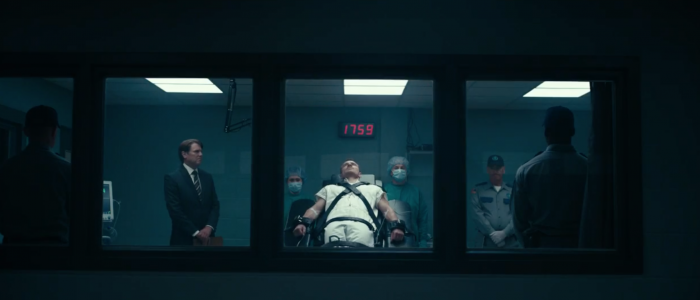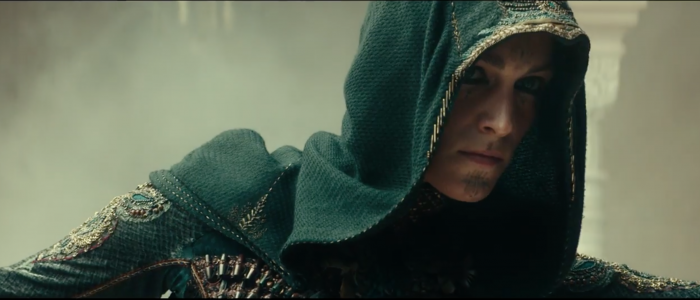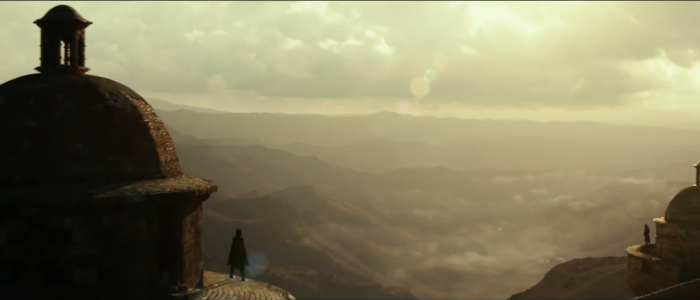'Assassin's Creed' Set Visit: A "Loose Adaptation" With Real Locations, Real Stunts, And Real Weapons
"We don't want this to be a superhero film; we want it to be a film that embraces what it is to be human," director Justin Kurzel said from the set of his adaptation of Assassin's Creed. Now, for most video game adaptations or huge tentpole films in general, such a comment would sound too good to be true–but this is coming from the director Snowtown Murders and last year's Macbeth. Video game adaptations often don't attract filmmakers of Kurzel's caliber (although there's another rare exception this year). He went from making a visceral and visually intoxicating William Shakespeare adaptation, which also starred Michael Fassbender and Marion Cotillard, to bringing Ubisoft's dense world to theaters.
Below, read our Assassin's Creed set visit.
Back in September, I had the opportunity to visit the set of Assassin's Creed, based on the video game franchise that started in 2007. By 2014, the franchise had sold over 73 million physical and digital copies, making it Ubisoft's most successful property. Fassbender isn't playing one of the series' more famous characters, like Altair or Ezio; he's playing Callum Lynch. On day 40 out of an 80-day shoot at Pinewood Studios, Lynch was ambushed by a group of guards, and a group of us in attendance that day got to witness it in one long, smooth take.
Before Lynch brutally, yet gracefully, takes out a few security guards in the film, he was given a second chance. The character is a Texas death row inmate. After receiving a lethal injection, he's brought back to life by Abstergo Industries, run by Alan Rikkin (Jeremy Irons) and his daughter, Sofia (Marion Cotillard), who's a scientist. She introduces Lynch to his new life, the life of an Assassin. Through a process called regression, the former drifter will relive the memories of his ancestor, Aguilar, a long-haired, face-tatted Assassin. During the Spanish Inquisition in 1491, Aguilar is protecting an artifact that Alan Rikkin, whose motive in the film is initially unknown, would like to get his hands on. There's more to the story than that–including the Assassins, also known as Assassin Brotherhood, fight against The Templar, a society against free will–but that's the basic gist of Assassin's Creed.

Whenever any of the cast or crew described the story or the world of the film, it sounded like an obstacle communicating it all with just one film, a hurdle actor/producer Michael Fassbender was well aware of during the development process. "The script is something we've always been working on, but we got to a place earlier this year where we felt we had a structure, and we had something that was simplified," Fassbender told us. "Because, as you all know, this is a very dense world, and trying to bring it to a cinematic experience is different. We tried to simplify as best we could and get the important aspects of the game across. There's a lot of for an audience to take on board. So to find a format where we could get these things across and keep it in a cinematic and dramatic experience, that was the challenge." Regarding how faithful the film is to the popular video game series, the Assassin's Creed star said they "want to respect the game and the elements to it," but that they "wanted to come up with our own thing."
By this point in production, Fassbender had been attached to Assassin's Creed for over three years. When asked what finally made the project come together, he said with a laugh: "We had a start date." In the film, Fassbender plays Lynch and Aguilar. The difference between the two? "Well, one doesn't say a lot and the other does," the actor responded, half-jokingly. "You know, basically in this story, you have somebody who doesn't realize where he's coming from. He doesn't have a lineage he can sort of feel a belonging to. That's our modern-day protagonist, Cal. He doesn't realize he's an assassin; he's a bit of a lost soul. He's always been drifting in and out of correctional facilities. Then, of course, Aguilar is very much somebody that belongs to the Creed. He has a cause; he's sort of been following that cause. He belongs to it. So they're the two different standpoints of the character, and hopefully Aguilar will teach Cal, from the regressions, that he does belong to something. That's the main difference between the two characters."
Around 65% of the story takes place in present day. From a structural and visual standpoint, making the two time periods feel of a piece was a challenge. "That's been the most tricky thing," Kurzel said. "They both are very, very distinct, especially in the game. You do probably spend more time in the past in the game. The present settings are kind of transient settings pieces to get you into the past. In terms of setting up the film, we do spend probably, predominantly, a little bit more time in the present, setting up the lead character in Cal, and getting the audience to know him and understand him. We're continuously just trying to find ways in which there's a bridge between those two worlds. At the same time, there's something very exciting about going between two different palettes. The past feels very, like a Caravaggio painting. It's very rich and very seductive, like the game. The light in the game is just extraordinary. There's a romance to the history that we didn't want to lose, contrasted with this very sophisticated, architectural, heavily designed world with modern day templates."
The scenes set during the Spanish Inquisition were shot in Malta. At the end of the set visit, we were shown over 50 photos from that portion of the film, and the grimy but beautiful aesthetic unquestionably came from the mind behind last year's impressionistic and visually stunning Macbeth. These photos also prominently featured Ariane Labed (The Lobster), playing a fellow Assassin. We didn't learn a great deal about her character, Maria, but she left an impression with her fierce presence. Another pivotal supporting character is Moosa, a patient played by Michael K. Williams (Boardwalk Empire). Moosa's ancestor, Baptiste, relies more on "trickery and magic and voodoo" than hand-to-hand combat, Williams told us.

Kurzel is again working with cinematographer Adam Arkapaw, most famously known for season one of True Detective. The two met during their time at film school, and all these years later, they're working on their biggest project yet. "He understands light and understands how to tell a story through the movement of a camera," Kurzel said, speaking highly of the DP. "He's extraordinary with performance. I think after True Detective, there's a kind of classic style that he's developed now that ... A very in-camera style that grounds things but at the same time finds a magic to it that we're trying to embrace with this. He's been a huge part of the re-imagining of Assassin's Creed as a piece of cinema."
Abstergo Industries' home base was constructed to accommodate some technically challenging long takes. Soon after we arrived on the set we were brought into the Common Room, often filled with "zombie patients" in recovery. In this chamber, the patients can garden, play ping pong or basketball—activities intended to make them more at home, more human. There's nothing homey about the Common Room, though; it's more of a spruced up, futuristic jail.
Spread across the room were all sorts of thematically relevant signs:
The Common Room led to other sets–a security room, the cells, and one massive hallway. The fight scene we saw occurred in a circular corridor, and the camera captured most of the action in one take. "I think the same with the past, just trying to keep long action sequences that are not interrupted by the cuts," Kurzel explained. "As much as possible, and the actors have spent so much time rehearsing the actual kind of moves, we just wanted to make sure that we were embracing the hard work that they've done, and that it felt ... When you look at Michael doing something, it's Michael doing something. It's Michael parkouring or it's Michael having spent three weeks learning a certain move. I guess that kind of uninterrupted, sort of longer takes is something that is apparent in Adam's style, but it's also something that we've brought into the film." Green screen wasn't used often during the shoot. Kurzel wanted to keep the action grounded, taking advantage of real locations and real stunts.

We didn't get to see Lynch use any particular weapon during the brawl, but the assassin, both in the past and present, has no shortage of deadly blades at his disposal. A total of 3,000 weapons were constructed for the film. Shoes, pens, belt buckles, phones, and necklaces; all are weapons in the world of Assassin's Creed. "Some of these weapons were taken straight out of the games," weapons expert Tim Wildgoose told us. "All of the assassins in the games wear these wrist blades, where the blades spring out. This is just a modern version of the old version. We've built everything to work because it's more fun [that way]. The tendency with films is to do a special effect, where it's a trick, but we made it work for real and to still look beautiful. That was our brief for everything: Try to make everything look real while still having a very pretty, ornate weapon."
The weaponry room contained references to the game, and there will be plenty of Easter eggs in the film, both small and significant. "I don't think you can ignore the eagle point of view in the game," Kurzel said, in case anyone was worried eagle vision wasn't a part of the video game adaptation. "I think the notion and the idea of these assassins having the skills or sensitivity of an eagle and the whole notion of the leap of faith and flight and eagle vision ... There are certain aspects of just the character that we tried to work into rather than kind of copy certain sequences within the game. Again, it's just been trying to approach it through character."
We also didn't see any of Lynch jumping from rooftop to rooftop, of which there was plenty in the promising trailer, oddly cut to Kanye West's "I Am A God." Kurzel's approach to the parkour, again, came back to not wanting to turn Assassin's Creed into something it's not: a superhero movie. "All our jumps and all our parkouring, it has to feel as though you're watching it and thinking, 'On a good day I could do this," Kurzel — who remains the most compelling component of the film — said. "Otherwise, I think it goes into fantasy, which I don't think the game is about. Assassin's Creed is based on real history. They spent a lot of time basing it on real characters. The details are just completely true to the period. It's very important that it feels tangible, the film feels tangible, and it feels as though it has existed, but also that it just feels human."
***
Assassin's Creed opens in theaters December 21st.
